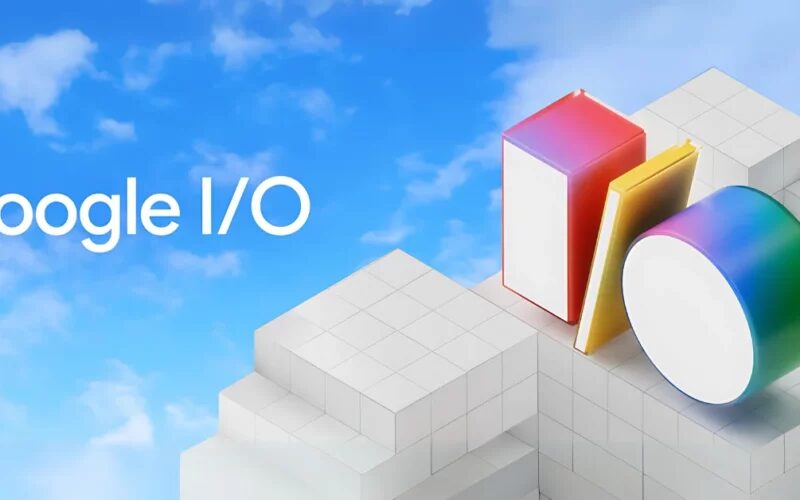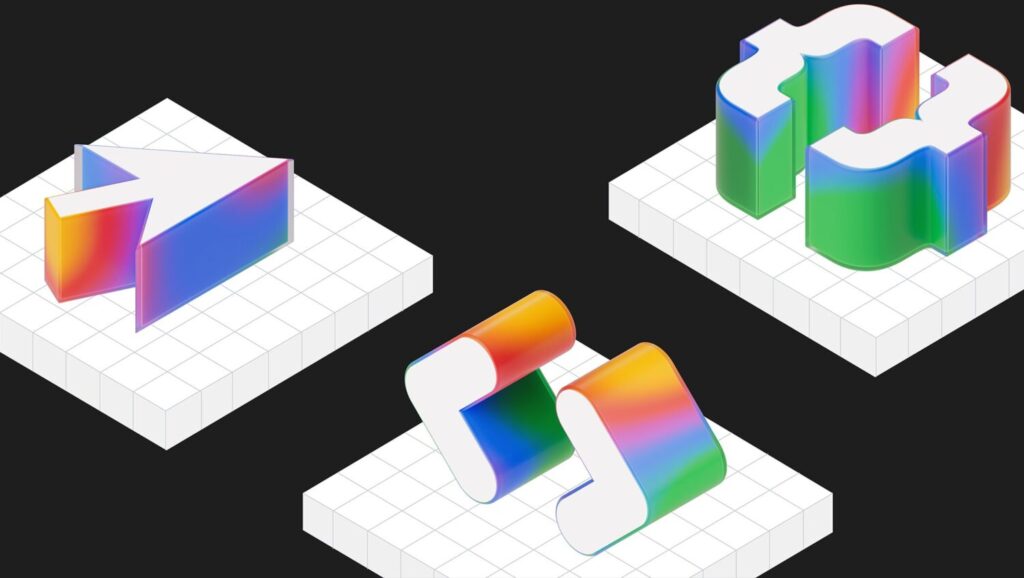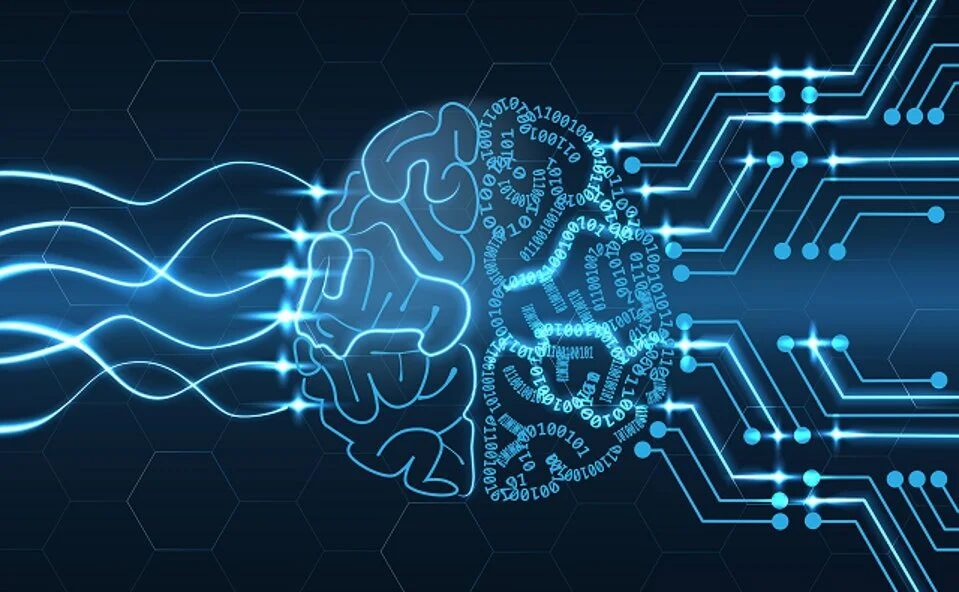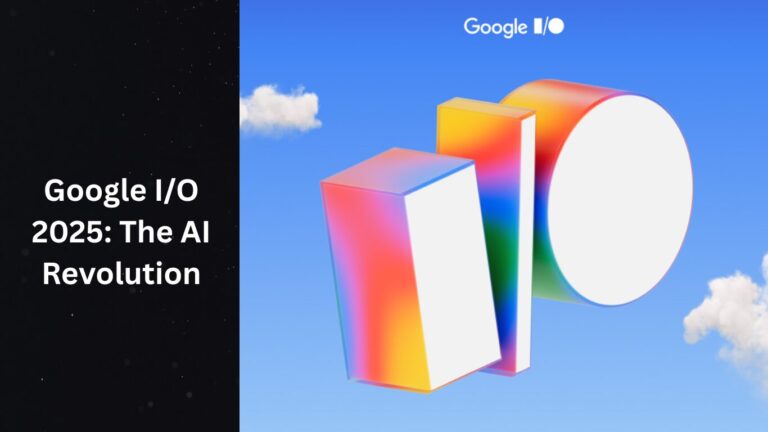Google I/O 2025 marked a watershed moment in artificial intelligence development, with Google unveiling 20 groundbreaking AI innovations that demonstrate the company’s commitment to “taking research into reality.” This comprehensive analysis examines how Google’s latest announcements position the company to dominate the AI landscape across content creation, enterprise solutions, consumer applications, and developer tools.
Media Generation Revolution

V3: Breakthrough Video Generation Model
Google’s V3 represents the most significant advancement in AI video generation, uniquely combining ultra-realistic video creation with synchronised audio generation. Unlike competitors such as Kling AI, V3 simultaneously produces background sounds, sound effects, and dialogue alongside video content. The model’s capabilities were demonstrated through Google I/O’s own launch video, showcasing spectacular visual quality with accurate real-world physics simulation.
Also Read – Top 5 AI Video Generators: The future of Marketing
Image Gen 4: Advanced Visual Content Creation
Positioned as Google’s answer to ChatGPT’s image generator, Image Gen 4 demonstrates exceptional proficiency in creating images with accurate text integration and diverse artistic styles from simple text prompts, representing a quantum leap in AI-powered visual content generation.
Also Read – Best GPT-4 Plugins: Use ChatGPT like a pro
Flow: Cinematic Storytelling Platform
Flow transforms content creation by enabling users to produce ultra-realistic movies rather than simple video clips. This revolutionary application harnesses both V3 and Image Gen 4 to facilitate sophisticated visual storytelling, allowing complete storyline creation through interconnected videos and images. Advanced editing capabilities include scene extension, cutting, and seamless element modification within existing footage.
Also Read – Best GPT-4 Plugins: Use ChatGPT like a pro
Lirya 2: Professional Music Generation
The audio generation landscape received a significant enhancement with Lirya 2, demonstrated through renowned composer Shankar Mahadevan’s AI-assisted musical creation. This development democratizes music production, making sophisticated audio generation accessible to creative professionals regardless of technical AI expertise.
Also Read – 10 Ways to Earn Money Using AI
E-commerce Transformation


Agentic Checkout: Automated Purchase Intelligence
This revolutionary system addresses e-commerce friction by automating the entire purchasing process. The system monitors items for price drops, automatically adds products to carts when prices decrease, selects appropriate sizes based on personal context, and streamlines checkout through integrated GPay functionality.
Also Read – Claude AI – Better than GPT-4?
Virtual Try-On Technology
Advanced virtual fitting technology allows users to upload full-body photographs alongside garment images. Using the sophisticated understanding of body structure, clothing fitting, and Gemini’s multimodal capabilities, the system creates precise virtual try-ons that help users visualise clothing appearance and fit.
Also Read – Best AI Tools for Students
Next-Generation Hardware


Android XR Glasses: 24/7 AI Assistant
Google’s return to smart eyewear represents a substantial evolution beyond the original Google Glass. These Android XR glasses function as continuous virtual assistants powered by Gemini, capable of environmental perception, contextual instruction provision, and memory retention for important information such as item locations. Navigation directions are projected directly into users’ field of view through an augmented reality overlay.
Also Read – Best AI Tools for Sales
Enterprise Collaboration Solutions


Google Beam: Ultra-High Fidelity Virtual Meetings
Building upon Project Starline technology, Google Beam creates unprecedented online meeting experiences. The system utilises sophisticated display units equipped with three strategically positioned cameras to capture a comprehensive 3D understanding of participants. This generates 60Hz high-fidelity, realistic 3D representations that closely replicate in-person meeting experiences.
Also Read – Best AI tools for startups
Enhanced Search Intelligence


Google Search AI Mode: Deep Research Capabilities
Powered by Gemini 2.5, this enhanced search mode provides comprehensive research capabilities by browsing hundreds of websites to identify relevant information while incorporating personal user context. The system delivers accurate, grounded information while minimising hallucinations through a dedicated deep research function that analyses multiple sources simultaneously.
Also Read – Best Cleanup Picture Tools
Autonomous AI Agents


Gemini Agent Mode: Task Automation Platform
This system transforms the Gemini app into an active agent capable of performing complex tasks autonomously. Examples include apartment hunting, where users input criteria prompting the agent to browse real estate websites, apply filters, and present optimal options directly within the interface.
Also Read – 15 Best AI Movies You Must Watch
Project Mariner: Advanced Workflow Automation
Significantly updated to run ten simultaneous tasks and available through the Gemini API, Project Mariner introduces “teach and repeat” functionality. Users demonstrate workflows for repetitive tasks such as invoice creation or design work, which the system then automates completely.
Also Read – 7 Best FREE AI Chatbots That Will Blow Your Mind
Multimodal Intelligence Platform


Project Astra Integration with Gemini Live
This sophisticated multimodal system enables users to show their surroundings for deeper, personalised, contextualised responses. Practical applications include component identification, repair assistance, software guidance, and screen-sharing support. The system engages in reasoning with users, correcting misunderstandings and providing nuanced explanations.
Also Read – Top 5 AI Video Generators: The future of Marketing
Advanced Language Models


Gemini 2.5 Model Family Expansion
Building upon 2.5 Pro’s recognition as the leading model according to LM Arena rankings, Google launched 2.5 Flash and 2.5 Flash Light for faster processing with comparable capabilities. Gemini 2.5 Pro deep thinking represents the most advanced model for complex reasoning in mathematics, coding, and multimodal applications.
Also Read – Best GPT-4 Plugins: Use ChatGPT like a pro
Gemini Text Diffusion: Revolutionary Text Generation
This innovative approach applies diffusion models—traditionally used for image creation—to text generation and problem-solving tasks. This methodology reportedly offers substantial speed improvements for mathematical questions and code generation compared to traditional language model approaches.
Also Read – 10 Ways to Earn Money Using AI
Development Ecosystem


Stitch: No-Code Application Development
This comprehensive platform enables users without design or coding knowledge to build applications from text prompts. The system generates prototypes as actual Figma designs, writes corresponding code, and creates deployable applications through Google’s platform, spanning the entire development workflow.
Also Read – Claude AI – Better than GPT-4?
Jules Coding Agent: Advanced Development Assistant
Serving as Google’s answer to GitHub Copilot and Replit, Jules creates entire codebases and understands existing codebase contexts to assist in generating functional applications from text input efficiently.
Also, read – 7 Best FREE AI Chatbots That Will Blow Your Mind
Browser Integration


Gemini in Chrome: Intelligent Browsing Assistant
This integration provides browsing agent capabilities through dedicated interface elements, allowing users to query current websites or request action execution. With complete Google suite access, the system executes tasks seamlessly within the browsing environment.
Also Read – Top 5 Upcoming NFT Projects
Pricing Strategy & Market Positioning
Tiered Subscription Model
Google’s pricing structure reflects perceived value across capability tiers:
- Free Tier: Limited access to basic AI tools and models
- Google AI Plan ($20/month): Access to V2, Flow, and standard AI tools
- Google AI Ultra ($250/month): Complete access to V3, Image Gen 4, Flow, and all agentic capabilities
This premium pricing strategy positions Google’s most advanced AI capabilities as professional-grade solutions while maintaining accessibility through lower tiers.
Conclusion
Google I/O 2025 represents a defining moment in artificial intelligence development, with Google unveiling innovations that will reshape technology landscapes across industries. The strategic integration of advanced AI capabilities into practical applications demonstrates Google’s commitment to leading the transition from AI research to real-world implementation. These announcements position Google not just as a technology provider but as the architect of an AI-integrated future that promises to transform how individuals and organisations interact with digital systems fundamentally.
Frequently Asked Questions (FAQs)
What is V3, and how does it differ from other AI video generation models?
V3 is Google’s advanced AI video generation model unveiled at Google I/O 2025. Unlike competitors like Kling AI, V3 uniquely combines ultra-realistic video creation with synchronised audio generation, producing background sounds, sound effects, and dialogue alongside visuals. It demonstrated spectacular visual quality with accurate real-world physics simulation during the Google I/O launch video.
How does the Google AI Ultra subscription tier differ from other pricing plans?
The Google AI Ultra plan, priced at $250/month, provides complete access to Google’s most advanced AI tools, including V3, Image Gen 4, Flow, and all agentic capabilities. In contrast, the free tier offers limited access to basic AI tools, while the Google AI Plan ($20/month) includes V2, Flow, and standard AI tools but lacks the full suite of advanced features available in the Ultra tier.
What capabilities does Project Astra offer when integrated with Gemini Live?
Project Astra, integrated with Gemini Live, is a multimodal intelligence platform that allows users to show their surroundings for personalized, contextual responses. It supports tasks like component identification, repair assistance, software guidance, and screen-sharing support. The system engages in reasoning, corrects misunderstandings, and provides nuanced explanations.
How does Google Beam enhance virtual meetings compared to traditional video conferencing?
Google Beam, built on Project Starline technology, uses sophisticated display units with three cameras to capture a comprehensive 3D understanding of participants. It generates 60Hz high-fidelity, realistic 3D representations, creating an online meeting experience that closely replicates in-person interactions, far surpassing the capabilities of traditional video conferencing platforms.
What is Stitch, and how does it support users without coding experience?
Stitch is a no-code application development platform introduced at Google I/O 2025. It enables users without design or coding knowledge to build applications from text prompts. Stitch generates prototypes as Figma designs, writes corresponding code, and creates deployable applications through Google’s platform, streamlining the entire development workflow for non-technical users.


